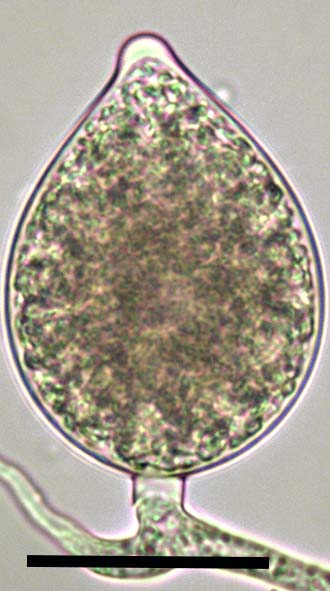Gallery
Image Type
Morphological Structure
Clades
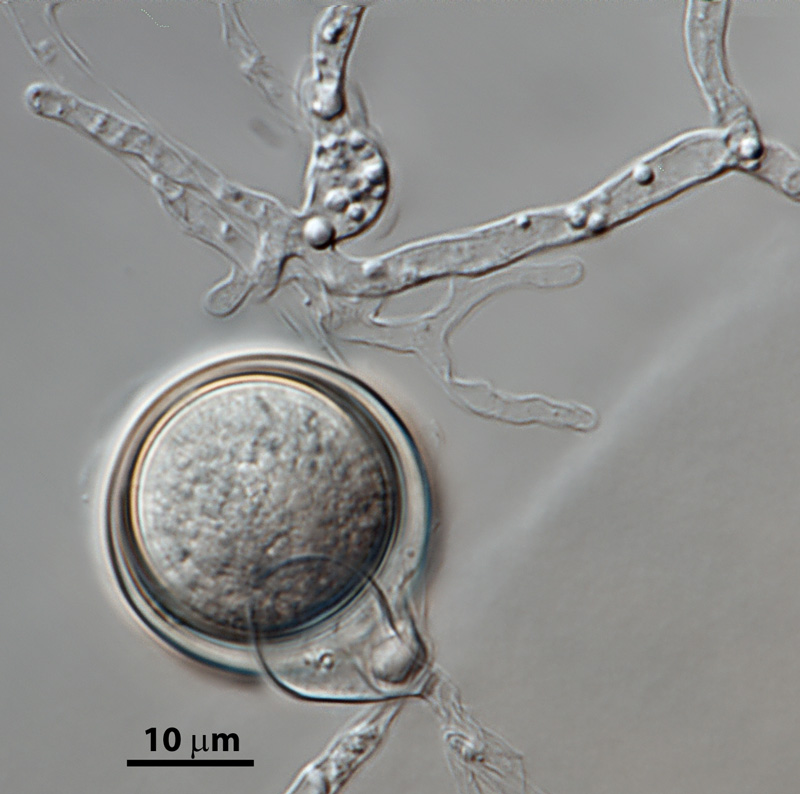 Phytophthora hedriandranbsp; (CPHST BL 4) sexual phase of the ex-type: smooth oogonium with paragynous antheridium and aplerotic oospore; photo by Gloria Abad, USDA-APHIS-PPQ.
Phytophthora hedriandranbsp; (CPHST BL 4) sexual phase of the ex-type: smooth oogonium with paragynous antheridium and aplerotic oospore; photo by Gloria Abad, USDA-APHIS-PPQ.
Phytophthora hedriandra (CPHST BL 4) sexual phase of the ex-type: smooth oogonium with paragynous antheridium and aplerotic oospore; photo by Gloria Abad, USDA-APHIS-PPQ.
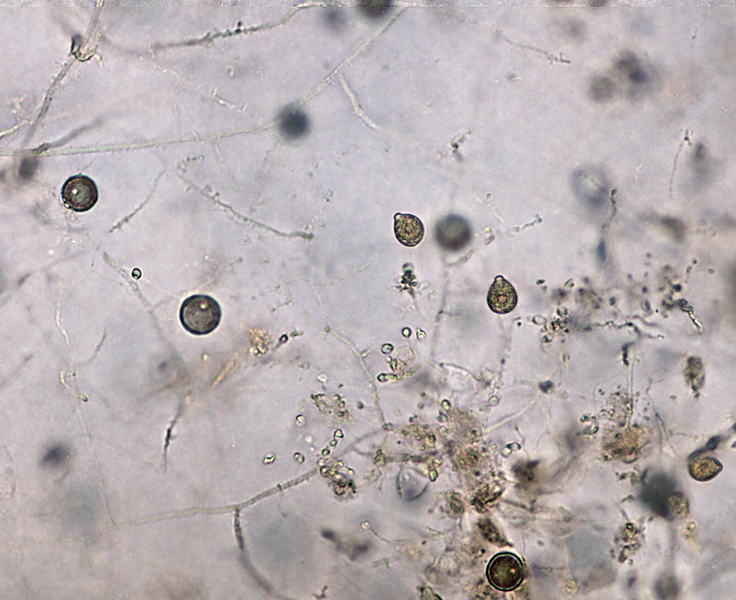 Phytophthora hedriandra (CPHST BL 4) asexual phase of the ex-type: sporangianbsp;and oospores; photonbsp;by Gloria Abad USDA-APHIS-PPQ.
Phytophthora hedriandra (CPHST BL 4) asexual phase of the ex-type: sporangianbsp;and oospores; photonbsp;by Gloria Abad USDA-APHIS-PPQ.
Phytophthora hedriandra (CPHST BL 4) asexual phase of the ex-type: sporangia and oospores; photo by Gloria Abad USDA-APHIS-PPQ.
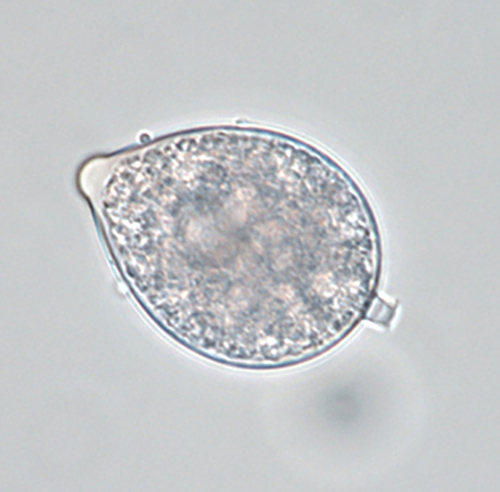 Phytophthora hedriandra (CPHST BL 4) asexual phase of the ex-type: sporangium papillate with caducous short pedicel; photos by Gloria Abad USDA-APHIS-PPQ.
Phytophthora hedriandra (CPHST BL 4) asexual phase of the ex-type: sporangium papillate with caducous short pedicel; photos by Gloria Abad USDA-APHIS-PPQ.
Phytophthora hedriandra (CPHST BL 4) asexual phase of the ex-type: sporangium papillate with caducous short pedicel; photos by Gloria Abad USDA-APHIS-PPQ.
Phytophthora spp. in Clade 4: portion of the seven-loci ML phylogeny featuring the type cultures of 212 described species (by T. Bourret). Notice the position of P. heterospora Ex-type CBS 148034 = S&T BL 119. Gloria Abad, USDA S&T.
Phytophthora spp. in Clade 4: Morphological Tabular key (PDF) and Tabular key legends (PDF) in IDphy2 KEY SECTION. Notice the data of P. heterospora Ex-type CBS 148034 = S&T BL 119. Gloria Abad, USDA S&T.
 colony morphology after 4 d growth at 20 ordm;C in the dark on carrot agar, V8A, CA, MEA, and PDA (from left to right)
colony morphology after 4 d growth at 20 ordm;C in the dark on carrot agar, V8A, CA, MEA, and PDA (from left to right)
colony morphology after 4 d growth at 20 ºC in the dark on carrot agar, V8A, CA, MEA, and PDA (from left to right)
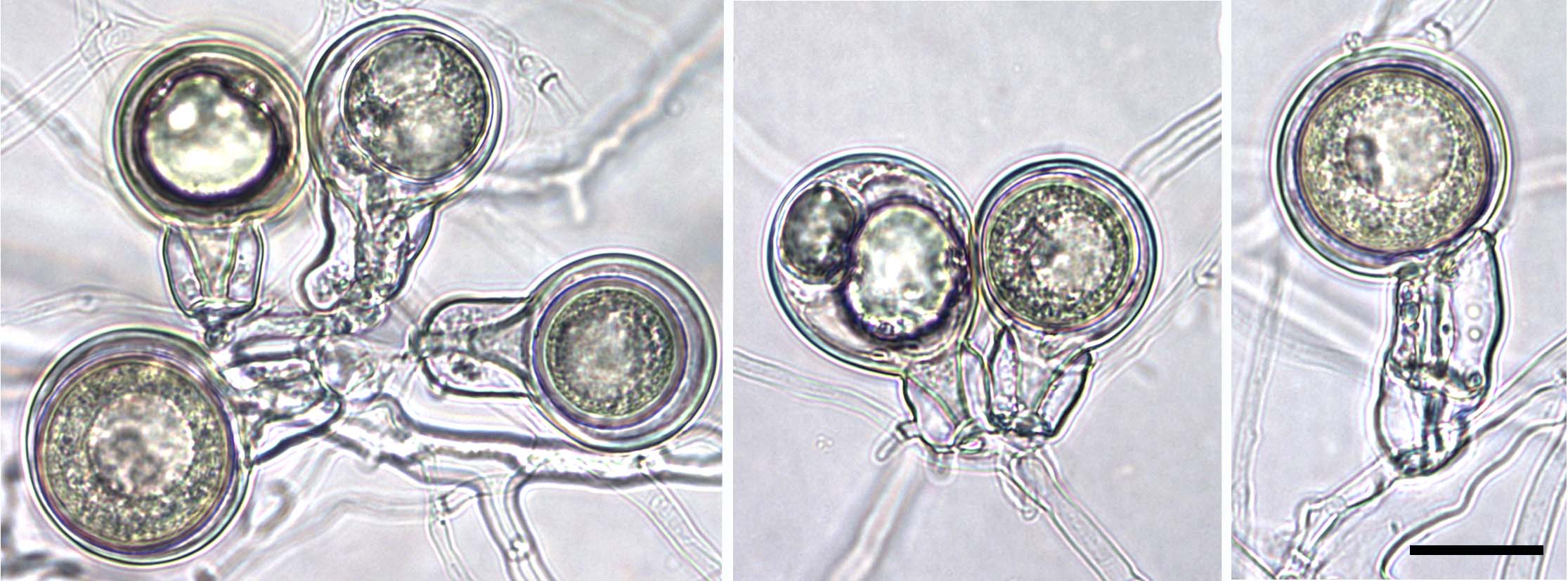 oogonia globose with aplerotic oospores, short tapering bases, often with aborted oospore; antheridia bicellular and often with finger-like projection (from left to right);nbsp;scale bar = 25 mu;m
oogonia globose with aplerotic oospores, short tapering bases, often with aborted oospore; antheridia bicellular and often with finger-like projection (from left to right);nbsp;scale bar = 25 mu;m
oogonia globose with aplerotic oospores, short tapering bases, often with aborted oospore; antheridia bicellular and often with finger-like projection (from left to right); scale bar = 25 μm
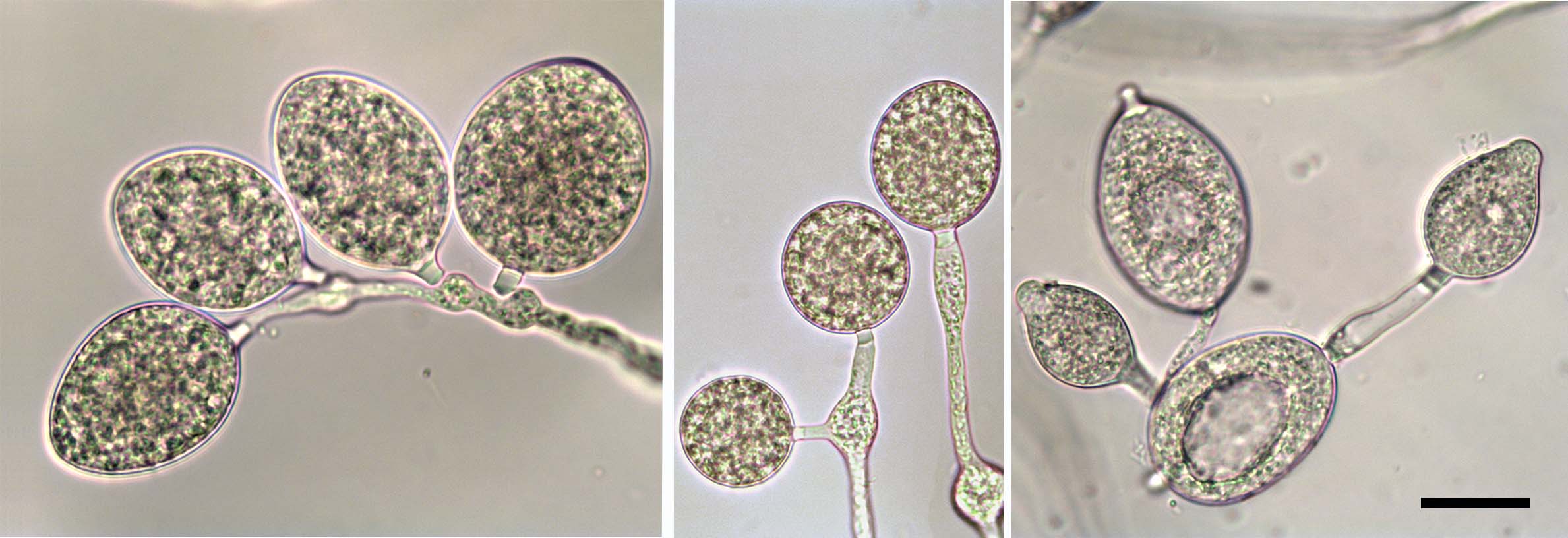 ovoid pseudoconidia forming monochasial helicoid sympodia, still attached to the conidiophores or recently detached with nodose swellings at the insertion points of the pseudoconidia to the conidiophores; spherical to ovoid pseudoconidia with short pre-formed pedicels; ovoid, laterally attached papillate sporangium; pseudoconidia germinating by forming papillate microsporangia and a new conidium (from left to right); scale bar = 25micro;m
ovoid pseudoconidia forming monochasial helicoid sympodia, still attached to the conidiophores or recently detached with nodose swellings at the insertion points of the pseudoconidia to the conidiophores; spherical to ovoid pseudoconidia with short pre-formed pedicels; ovoid, laterally attached papillate sporangium; pseudoconidia germinating by forming papillate microsporangia and a new conidium (from left to right); scale bar = 25micro;m
ovoid pseudoconidia forming monochasial helicoid sympodia, still attached to the conidiophores or recently detached with nodose swellings at the insertion points of the pseudoconidia to the conidiophores; spherical to ovoid pseudoconidia with short pre-formed pedicels; ovoid, laterally attached papillate sporangium; pseudoconidia germinating by forming papillate microsporangia and a new conidium (from left to right); scale bar = 25µm
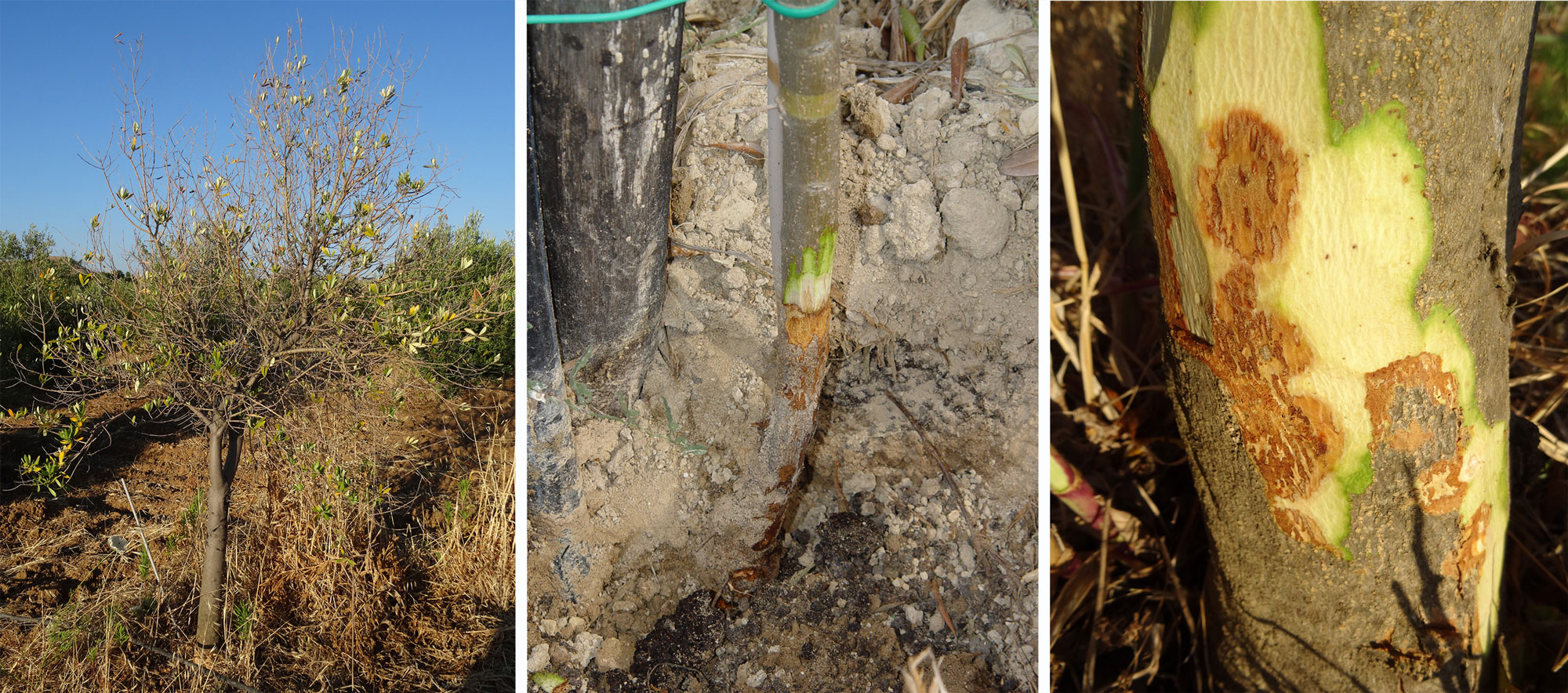 disease symptoms on Olea europaea : 4-year-old tree showing chlorosis and increased transparency of the crown; orange-brown and flame shaped lesions on the stem; single-spot bark lesions on the main stem
disease symptoms on Olea europaea : 4-year-old tree showing chlorosis and increased transparency of the crown; orange-brown and flame shaped lesions on the stem; single-spot bark lesions on the main stem
disease symptoms on Olea europaea: 4-year-old tree showing chlorosis and increased transparency of the crown; orange-brown and flame shaped lesions on the stem; single-spot bark lesions on the main stem
Phytophthora spp. in Clade 5: portion of the seven-loci ML phylogeny featuring the type cultures of 212 described species (by T. Bourret). Notice the position of P. heveae Ex-type CBS 296.29 = S&T BL 67. Gloria Abad, USDA S&T.
Phytophthora spp. in Clade 5: Morphological Tabular key (PDF) and Tabular key legends (PDF) in IDphy2 KEY SECTION. Notice the data of P. heveae Ex-type CBS 296.29 = S&T BL 67. Gloria Abad, USDA S&T.
 Phytophthora heveae (CPHST BL 67) colonies of the ex-type grown for 7 days on (a) V8reg; Agar, (b) potato dextrose agar, and (c) malt extract agar; photo by Krysta Jennings and Leandra Knight, USDA-APHIS-PPQ
Phytophthora heveae (CPHST BL 67) colonies of the ex-type grown for 7 days on (a) V8reg; Agar, (b) potato dextrose agar, and (c) malt extract agar; photo by Krysta Jennings and Leandra Knight, USDA-APHIS-PPQ
Phytophthora heveae (CPHST BL 67) colonies of the ex-type grown for 7 days on (a) V8® Agar, (b) potato dextrose agar, and (c) malt extract agar; photo by Krysta Jennings and Leandra Knight, USDA-APHIS-PPQ
Phytophthora heveae (P10167, selected specimen) asexual phase: (a) sporangia in sporangiophores; (b–g) papillate sporangia, persistent and caducous - with pedicels (blue arrows); (f) bipapillate sporangium, (g) sporangium with external proliferation; photos by Gloria Abad, USDA-APHIS-PPQ.
Phytophthora heveae (P10167, selected specimen) homothallic sexual phase: (a–d) smooth-walled oogonia frequently with tapered bases; amphigynous antheridia and aplerotic oospores; photos by Gloria Abad, USDA-APHIS-PPQ.
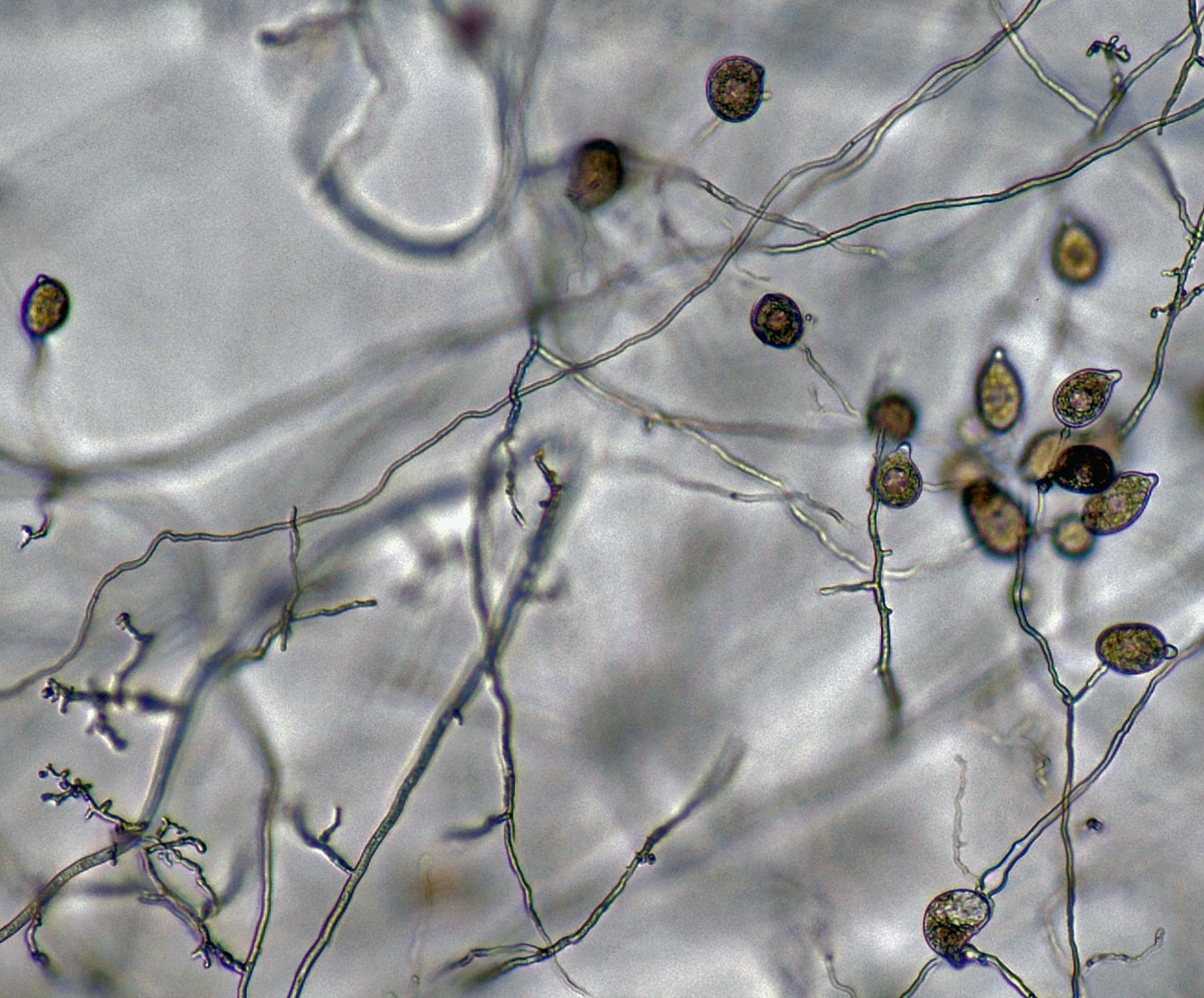 Phytophthora heveae nbsp;(P10167, selected specimen) asexual phase: persistent papillate sporangia and sporangiophores; photonbsp;by Gloria Abad, USDA-APHIS-PPQ.
Phytophthora heveae nbsp;(P10167, selected specimen) asexual phase: persistent papillate sporangia and sporangiophores; photonbsp;by Gloria Abad, USDA-APHIS-PPQ.
Phytophthora heveae (P10167, selected specimen) asexual phase: persistent papillate sporangia and sporangiophores; photo by Gloria Abad, USDA-APHIS-PPQ.
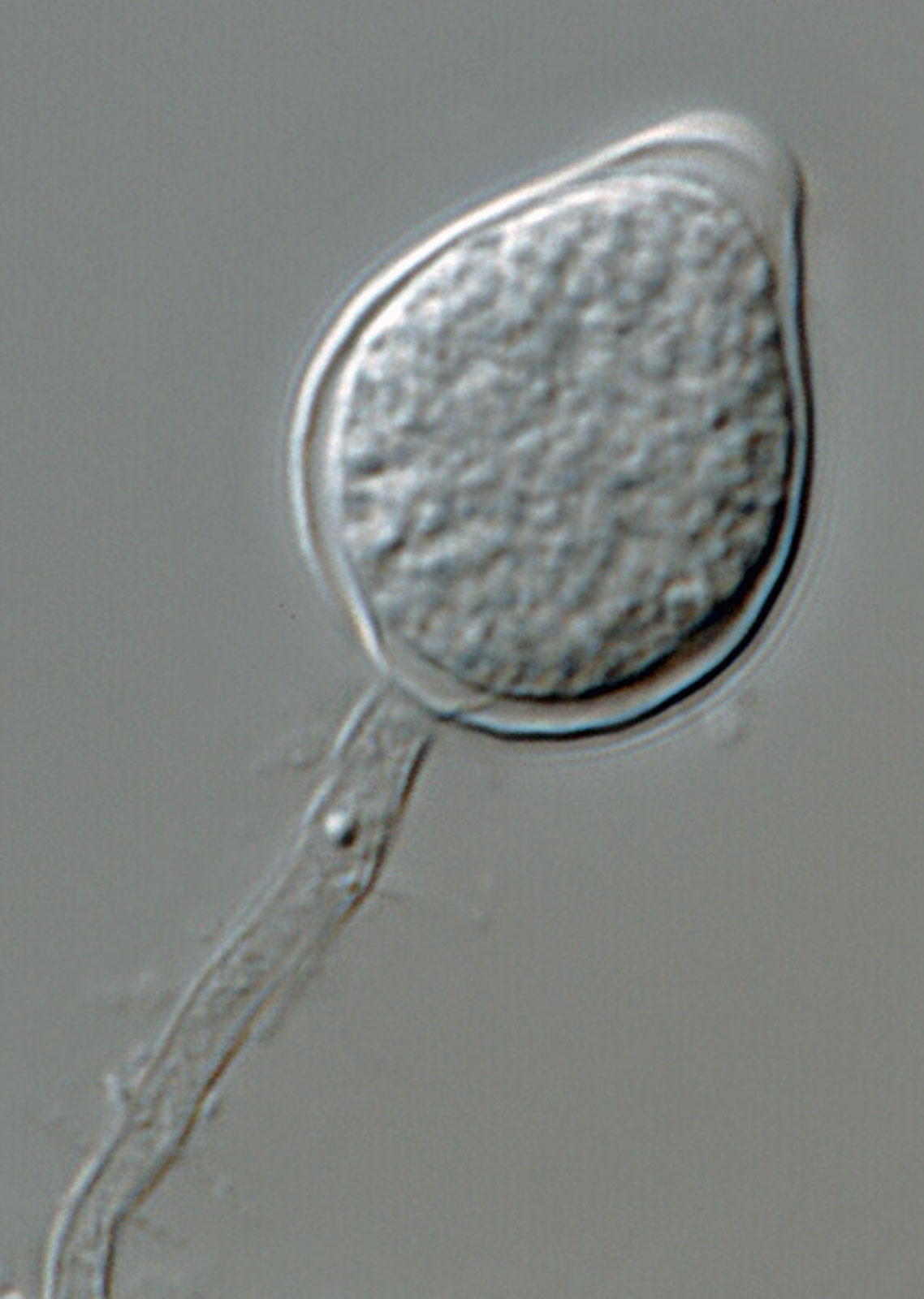 Phytophthora heveae nbsp;(P10167, selected specimen) asexual phase: papillate sporangium with persistent pedicel; photonbsp;by Gloria Abad, USDA-APHIS-PPQ.
Phytophthora heveae nbsp;(P10167, selected specimen) asexual phase: papillate sporangium with persistent pedicel; photonbsp;by Gloria Abad, USDA-APHIS-PPQ.
Phytophthora heveae (P10167, selected specimen) asexual phase: papillate sporangium with persistent pedicel; photo by Gloria Abad, USDA-APHIS-PPQ.
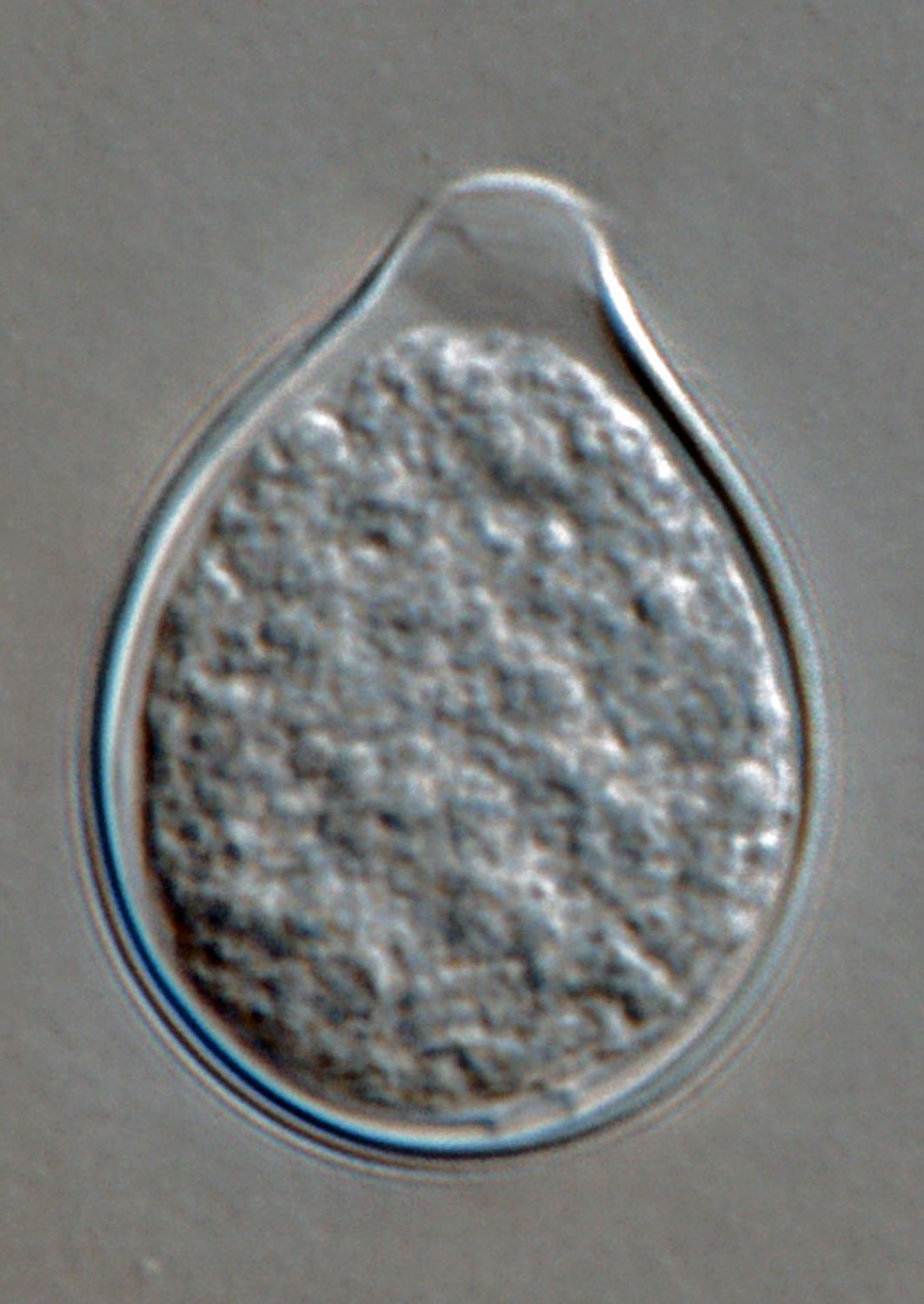 Phytophthora heveae nbsp;(P10167, selected specimen) asexual phase:nbsp;papillate sporangium; photonbsp;by Gloria Abad, USDA-APHIS-PPQ.
Phytophthora heveae nbsp;(P10167, selected specimen) asexual phase:nbsp;papillate sporangium; photonbsp;by Gloria Abad, USDA-APHIS-PPQ.
Phytophthora heveae (P10167, selected specimen) asexual phase: papillate sporangium; photo by Gloria Abad, USDA-APHIS-PPQ.
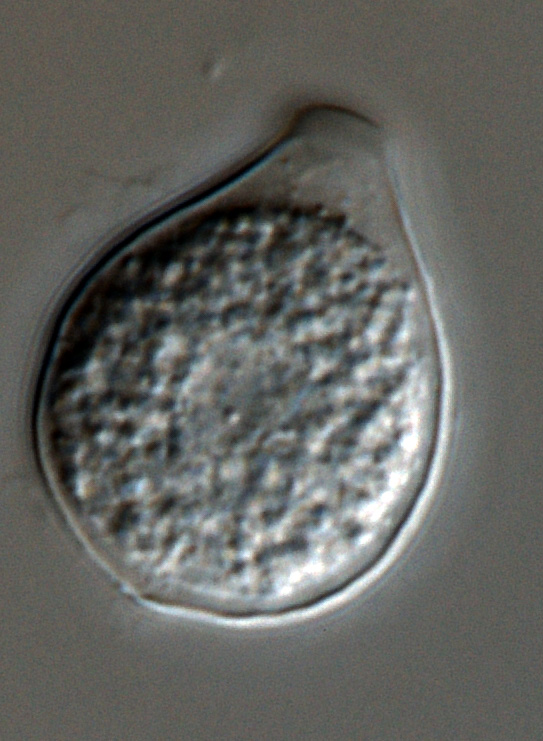 Phytophthora heveae nbsp;(P10167, selected specimen) asexual phase:nbsp;papillate sporangium; photonbsp;by Gloria Abad, USDA-APHIS-PPQ.
Phytophthora heveae nbsp;(P10167, selected specimen) asexual phase:nbsp;papillate sporangium; photonbsp;by Gloria Abad, USDA-APHIS-PPQ.
Phytophthora heveae (P10167, selected specimen) asexual phase: papillate sporangium; photo by Gloria Abad, USDA-APHIS-PPQ.
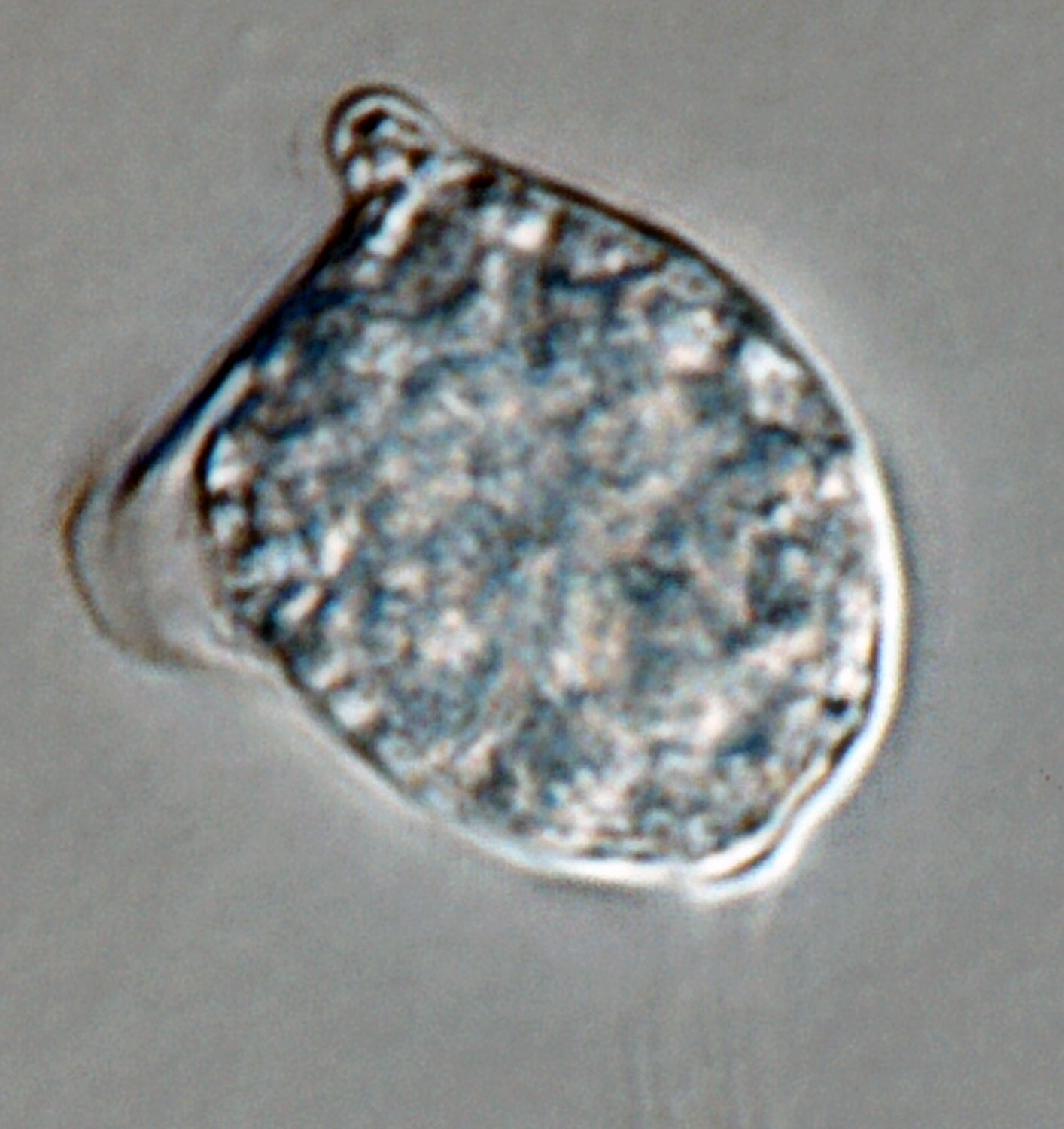 Phytophthora heveae nbsp;(P10167, selected specimen) asexual phase: bipapillate caducousnbsp;sporangium withnbsp;pedicel; photonbsp;by Gloria Abad, USDA-APHIS-PPQ.
Phytophthora heveae nbsp;(P10167, selected specimen) asexual phase: bipapillate caducousnbsp;sporangium withnbsp;pedicel; photonbsp;by Gloria Abad, USDA-APHIS-PPQ.
Phytophthora heveae (P10167, selected specimen) asexual phase: bipapillate caducous sporangium with pedicel; photo by Gloria Abad, USDA-APHIS-PPQ.
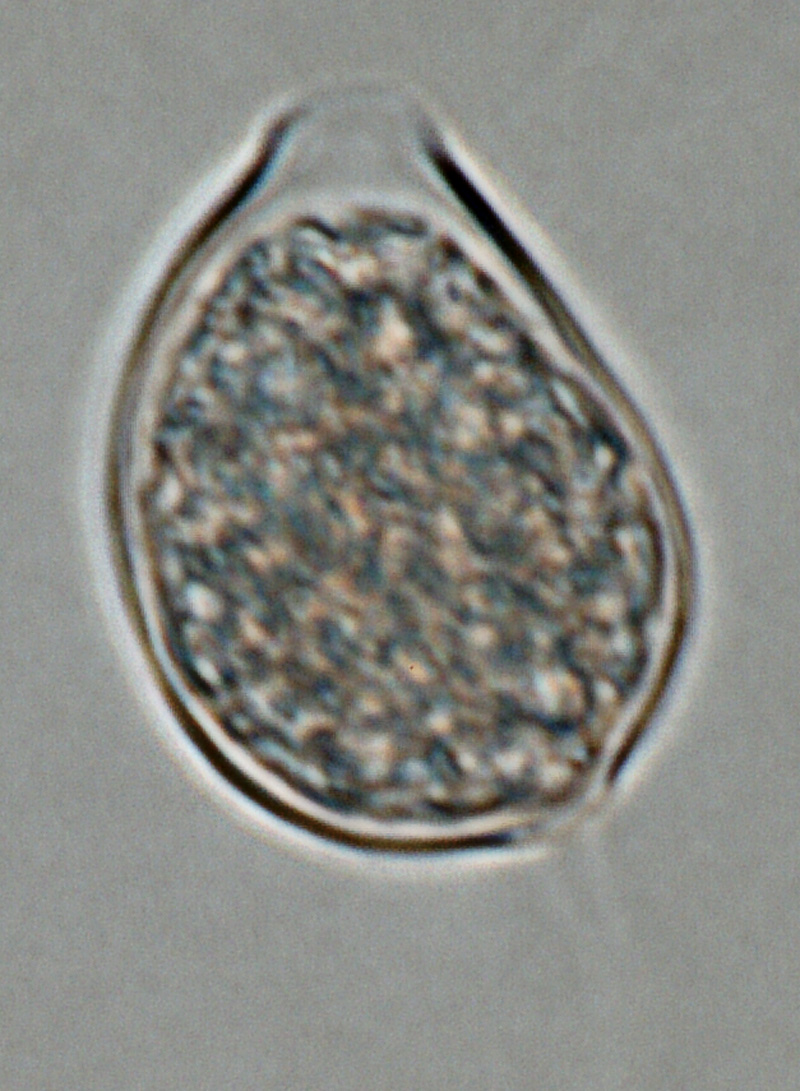 Phytophthora heveae nbsp;(P10167, selected specimen) asexual phase:nbsp;papillate caducousnbsp;sporangium with pedicel; photonbsp;by Gloria Abad, USDA-APHIS-PPQ.
Phytophthora heveae nbsp;(P10167, selected specimen) asexual phase:nbsp;papillate caducousnbsp;sporangium with pedicel; photonbsp;by Gloria Abad, USDA-APHIS-PPQ.
Phytophthora heveae (P10167, selected specimen) asexual phase: papillate caducous sporangium with pedicel; photo by Gloria Abad, USDA-APHIS-PPQ.
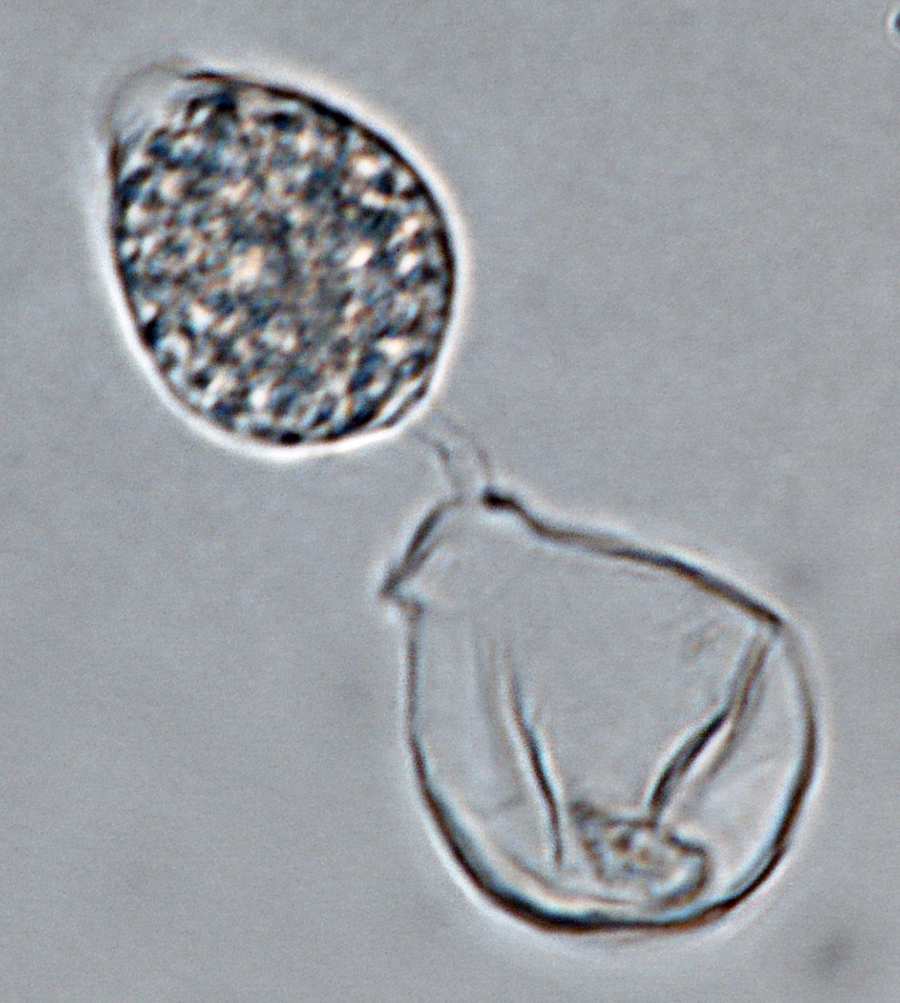 Phytophthora heveae nbsp;(P10167, selected specimen) asexual phase: sporangium with external proliferation; photonbsp;by Gloria Abad, USDA-APHIS-PPQ.
Phytophthora heveae nbsp;(P10167, selected specimen) asexual phase: sporangium with external proliferation; photonbsp;by Gloria Abad, USDA-APHIS-PPQ.
Phytophthora heveae (P10167, selected specimen) asexual phase: sporangium with external proliferation; photo by Gloria Abad, USDA-APHIS-PPQ.
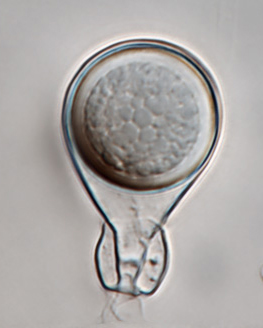 Phytophthora heveae nbsp;(P10167, selected specimen) homothallic sexual phase: smooth-walled oogoniumnbsp;with tapered base; amphigynous antheridiumnbsp;and aplerotic oospore; photo by Gloria Abad, USDA-APHIS-PPQ.
Phytophthora heveae nbsp;(P10167, selected specimen) homothallic sexual phase: smooth-walled oogoniumnbsp;with tapered base; amphigynous antheridiumnbsp;and aplerotic oospore; photo by Gloria Abad, USDA-APHIS-PPQ.
Phytophthora heveae (P10167, selected specimen) homothallic sexual phase: smooth-walled oogonium with tapered base; amphigynous antheridium and aplerotic oospore; photo by Gloria Abad, USDA-APHIS-PPQ.
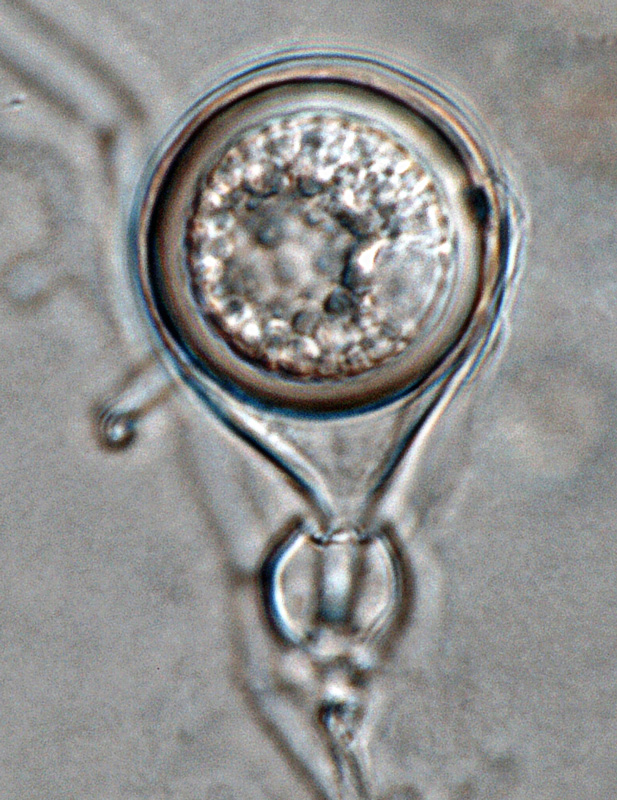 Phytophthora heveae nbsp;(P10167, selected specimen) homothallic sexual phase: smooth-walled oogoniumnbsp;with tapered base; amphigynous antheridiumnbsp;and aplerotic oospore; photo by Gloria Abad, USDA-APHIS-PPQ.
Phytophthora heveae nbsp;(P10167, selected specimen) homothallic sexual phase: smooth-walled oogoniumnbsp;with tapered base; amphigynous antheridiumnbsp;and aplerotic oospore; photo by Gloria Abad, USDA-APHIS-PPQ.
Phytophthora heveae (P10167, selected specimen) homothallic sexual phase: smooth-walled oogonium with tapered base; amphigynous antheridium and aplerotic oospore; photo by Gloria Abad, USDA-APHIS-PPQ.
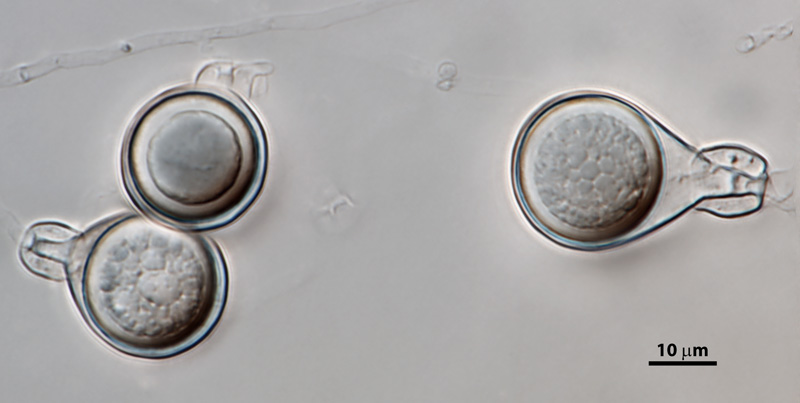 Phytophthora heveae nbsp;(P10167, selected specimen) homothallic sexual phase: smooth-walled oogonianbsp;with tapered bases; amphigynous antheridianbsp;and aplerotic oospores; photo by Gloria Abad, USDA-APHIS-PPQ.
Phytophthora heveae nbsp;(P10167, selected specimen) homothallic sexual phase: smooth-walled oogonianbsp;with tapered bases; amphigynous antheridianbsp;and aplerotic oospores; photo by Gloria Abad, USDA-APHIS-PPQ.
Phytophthora heveae (P10167, selected specimen) homothallic sexual phase: smooth-walled oogonia with tapered bases; amphigynous antheridia and aplerotic oospores; photo by Gloria Abad, USDA-APHIS-PPQ.
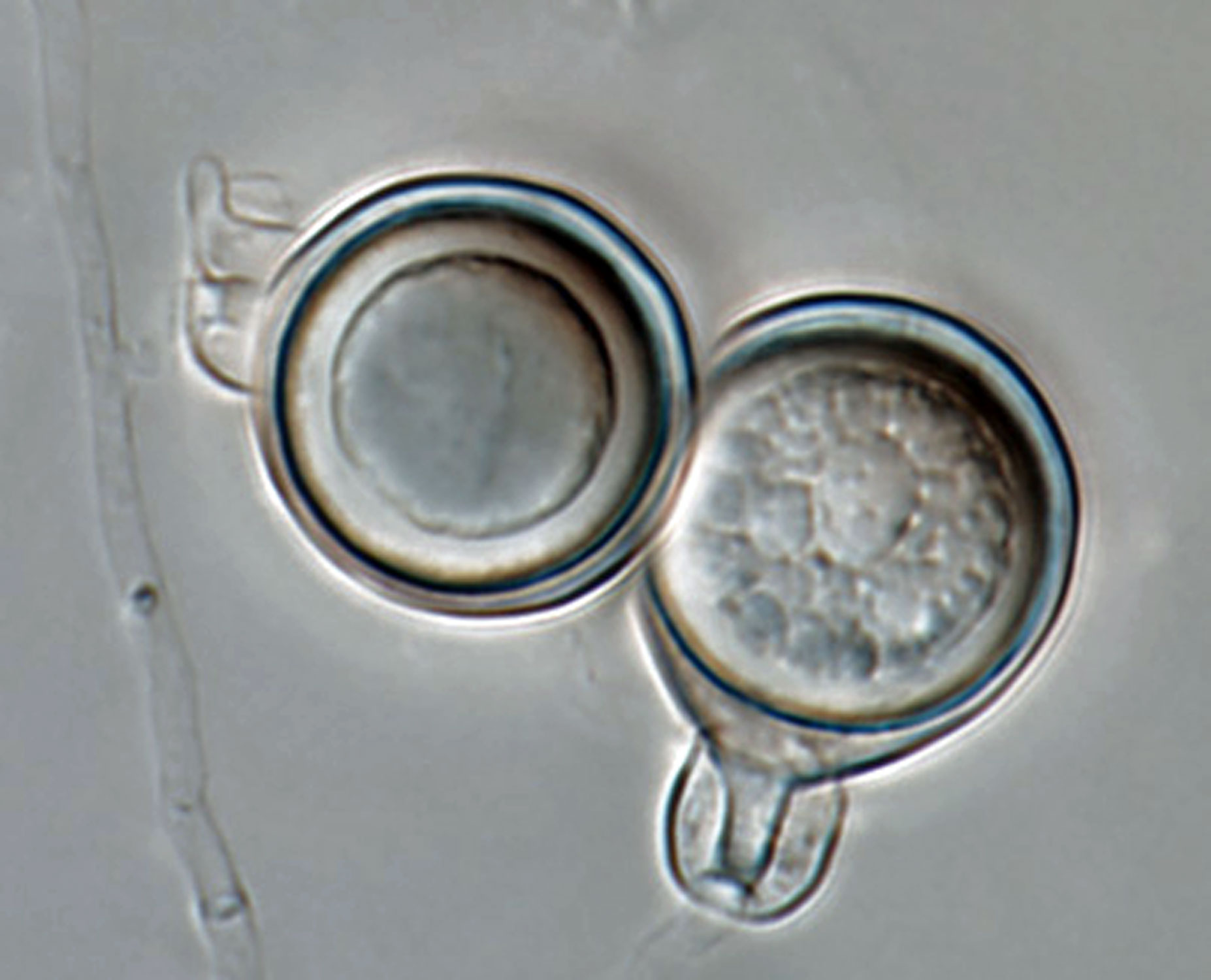 Phytophthora heveae nbsp;(P10167, selected specimen) homothallic sexual phase: smooth-walled oogonianbsp;with tapered bases; amphigynous antheridianbsp;and aplerotic oospores; photo by Gloria Abad, USDA-APHIS-PPQ.
Phytophthora heveae nbsp;(P10167, selected specimen) homothallic sexual phase: smooth-walled oogonianbsp;with tapered bases; amphigynous antheridianbsp;and aplerotic oospores; photo by Gloria Abad, USDA-APHIS-PPQ.
Phytophthora heveae (P10167, selected specimen) homothallic sexual phase: smooth-walled oogonia with tapered bases; amphigynous antheridia and aplerotic oospores; photo by Gloria Abad, USDA-APHIS-PPQ.
 Phytophthora heveae nbsp;(P10167, selected specimen) homothallic sexual phase: smooth-walled oogonianbsp;with tapered bases; amphigynous antheridianbsp;and aplerotic oospores; photo by Gloria Abad, USDA-APHIS-PPQ.
Phytophthora heveae nbsp;(P10167, selected specimen) homothallic sexual phase: smooth-walled oogonianbsp;with tapered bases; amphigynous antheridianbsp;and aplerotic oospores; photo by Gloria Abad, USDA-APHIS-PPQ.
Phytophthora heveae (P10167, selected specimen) homothallic sexual phase: smooth-walled oogonia with tapered bases; amphigynous antheridia and aplerotic oospores; photo by Gloria Abad, USDA-APHIS-PPQ.
Phytophthora spp. in subclade 8c: portion of the seven-loci ML phylogeny featuring the type cultures of 212 described species (by T. Bourret). Notice the position of P. hibernalis selected specimen CBS 114104 = S&T BL 41G. Gloria Abad, USDA S&T.
Phytophthora spp. in subclade 8c: Morphological Tabular key (PDF) and Tabular key legends (PDF) in IDphy2 KEY SECTION. Notice the data of P. hibernalis selected specimen CBS 114104 = S&T BL 41G. Gloria Abad, USDA S&T.
 Phytophthora hibernalis (CPHST BL 41G) colonies of the ex-epitype grown for 7 days on (a) V8reg; Agar, (b) potato dextrose agar, and (c) malt extract agar; photo by Krysta Jennings and Leandra Knight, USDA-APHIS-PPQ
Phytophthora hibernalis (CPHST BL 41G) colonies of the ex-epitype grown for 7 days on (a) V8reg; Agar, (b) potato dextrose agar, and (c) malt extract agar; photo by Krysta Jennings and Leandra Knight, USDA-APHIS-PPQ
Phytophthora hibernalis (CPHST BL 41G) colonies of the ex-epitype grown for 7 days on (a) V8® Agar, (b) potato dextrose agar, and (c) malt extract agar; photo by Krysta Jennings and Leandra Knight, USDA-APHIS-PPQ
 Phytophthora hibernalis (CPHST BL 41G) sporangia in sporangiophore; photo by Gloria Abad, USDA-APHIS-PPQ
Phytophthora hibernalis (CPHST BL 41G) sporangia in sporangiophore; photo by Gloria Abad, USDA-APHIS-PPQ
Phytophthora hibernalis (CPHST BL 41G) sporangia in sporangiophore; photo by Gloria Abad, USDA-APHIS-PPQ
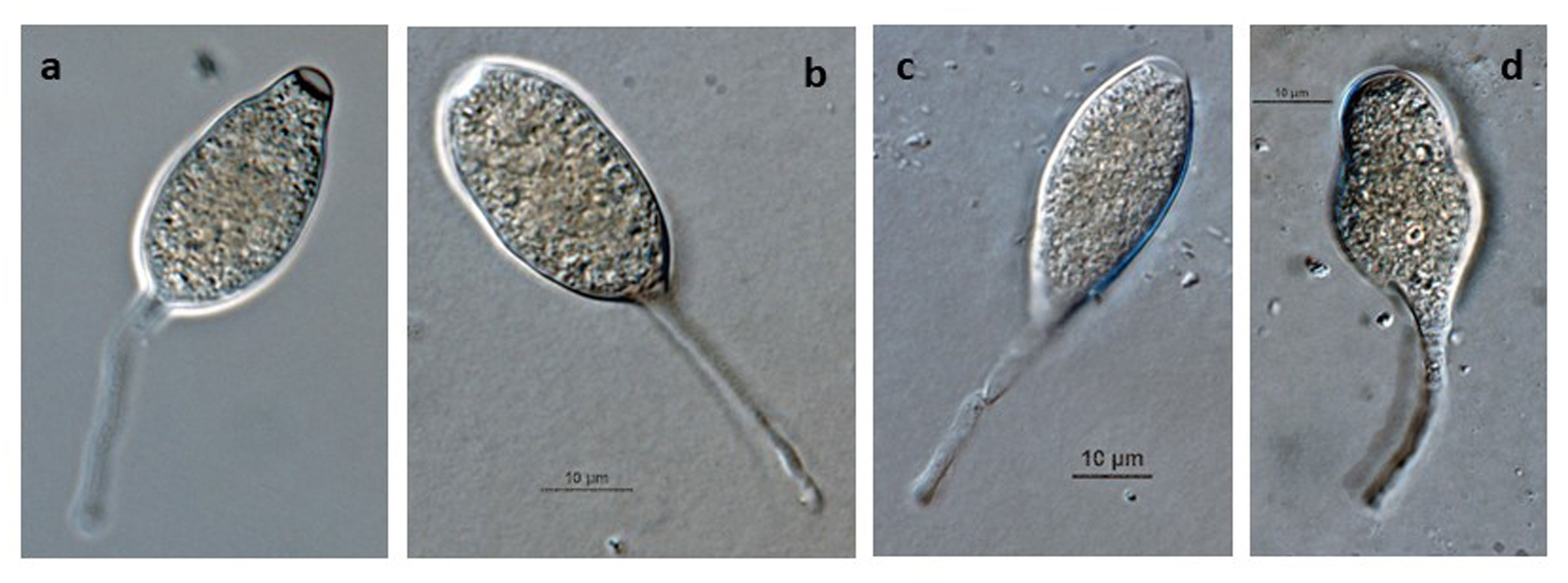 Phytophthora hibernalis nbsp;(CPHST BL 41G) asexual phase: (andash;d) semipapillate sporangia, caducous with medium to long pedicels; photos by Gloria Abad, USDA-APHIS-PPQ.
Phytophthora hibernalis nbsp;(CPHST BL 41G) asexual phase: (andash;d) semipapillate sporangia, caducous with medium to long pedicels; photos by Gloria Abad, USDA-APHIS-PPQ.
Phytophthora hibernalis (CPHST BL 41G) asexual phase: (a–d) semipapillate sporangia, caducous with medium to long pedicels; photos by Gloria Abad, USDA-APHIS-PPQ.

